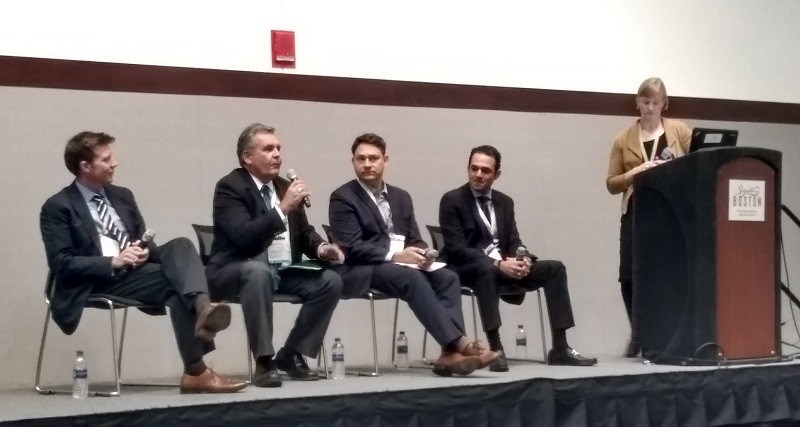Shining a Light on the Underground Energy-Water Nexus

Why hasn’t saving water as a way of saving energy had its day in the sun yet in the United States? At Horizon18 in Boston on Oct. 11, speakers at the session “Smart Water Solutions and the Energy-Water Nexus” reflected on the sparkle of hope that they believed these solutions provide.
“This is an opportunity. There’s energy that can be captured in wastewater plants. There’s energy that can be captured through turbines. One challenge is: it ain’t sexy. We aren’t talking solar power, windmills, or mirrors in the middle of the desert. People don’t think about it,” said Reese Tisdale, president of Bluefield Research.
But even though these differences exist, one can still draw an analogy between the energy industry and the water industry.
“We talk about the electric utility of the future. There’s an analogous transformation that’s underway in the water sector,” said Jacqueline Ashmore, executive director of Boston University’s Institute for Sustainable Energy.
This transformation involves using advanced metering infrastructure (AMI) to respond to the challenges of climate change, energy efficiency, water conservation, and customer service.
And the evidence of these changes was right under conference attendees’ feet. In downtown Boston, some of these new technologies and ideas are being put into play. The speakers described the innovations that are taking place.
What surprises exist underneath the streets of Boston?
The city is quietly installing sophisticated data management for water solutions.
“The biggest challenge we have right now is sea-level rise,” said John Sullivan, chief engineer at Boston Water and Sewer Commission. “We have plans. We’re collecting data. We do not need to retreat from the sea; we need to work with the sea. We need to get more data points inside our sewer systems to figure out what’s happening.”
These data can help Boston residents survive flooding due to climate change.
“We’re doing an inundation model,” Sullivan said. “If we get 14-15 inches of rain, a bunch of people will [have their neighborhoods] flooded for a while. Can we just walk them out? Do we need boats? Bringing together all this information, we can put together a model. This allows us to preposition instrumentation to tell us what the sewer is doing.”
Boston’s sewer system is very old. Some pipes have been there for hundreds of years. And now they’re being outfitted with AMI equipment.
“Our oldest water pipe is from 1848,” Sullivan said. “It has never broken. We rehab it. It has 200 more years left in it. We don’t have main breaks often. Our sewer system is very old also.”
Putting new technologies to use, water organizations can now tap into data about how their systems are performing.
“We’re now putting a system that listens for water leaks across the city,” Sullivan said. “We collect all these meter data. We publish every homeowner’s water data in a graphic on our website.”
A computer at Boston Water and Sewer Commission keeps an eye on water losses. Staff can contact individual customers to let them know if there are issues.
“It’s extremely expensive to get these systems in,” Sullivan said. “You can’t do a business case just by making customers happy.”
So where does the cost justification come into play? That requires looking at the numbers – and considering the costs of climate change. It also involves persuading reluctant stakeholders to modernize their systems.
“There isn’t enough market awareness about energy efficiency for water utilities,” said George Demosthenous, CEO of Voda. “We are onboarding [water utilities] as new customers. Utilities around the world could save up to 1 billion kW per year. We can make a positive impact that can help tilt the course of climate change.”
Demosthenous said using artificial intelligence such as the tools Voda develops can help water utilities respond to climate issues. “In places like Florida that flood, they’re paying even more to boost that water to consumers to maintain the pressure. We figured out that they could have a tremendous amount of savings if they used a proactive solution like Voda.”
“The AMI hourly data can give you a lot of valuable insights,” Demosthenous said. “You can take leak detection data and merge these data. New technologies are available because of machine learning and AMI. Technologies are advancing quickly.”
Sullivan said his millennial coworkers are enthusiastic about data analysis. He said they “are fantastic at taking and manipulating data.” He said he cautions his new coworkers about the importance of understanding what the data mean before drawing conclusions.
“The millennials that are taking over these jobs care about ease of use and interface,” Demosthenous said.
As the water industry transforms itself, inviting millennial staff and computer scientists in is just part of that evolution. This issue is similar to challenges faced by the electric-power industry.
“The world we live in is ever more data-heavy. That’s coming to the water sector too,” Ashmore said.
The speed at which different states adopt these innovations may depend on the urgency of the floods and droughts they face.
“All these-water starved states like Texas and California are massively challenged and very active,” Ashmore said.
“California is a unique market,” Tisdale said. “[Water treatment plants] install battery systems onsite. They also sign a power-purchase agreement with the electric utility. They’ve been able to take advantage of a regulatory environment that’s favorable to them. If there’s excess capacity, they can supply Southern California Edison. They’re also looking at other markets where there’s an opportunity.”
These synergies can and should be explored further, the panelists said.
“Creating more interaction between the energy community and the water community is a great idea,” Ashmore said. “There’s a ton of great work going on in the energy community and a lot of great work going on in the water community as well. Fundamentally, I’m an energy geek and I’m also a water geek.”
To comment on this article, please post in our LinkedIn group, contact us on Twitter, or use our contact form.
